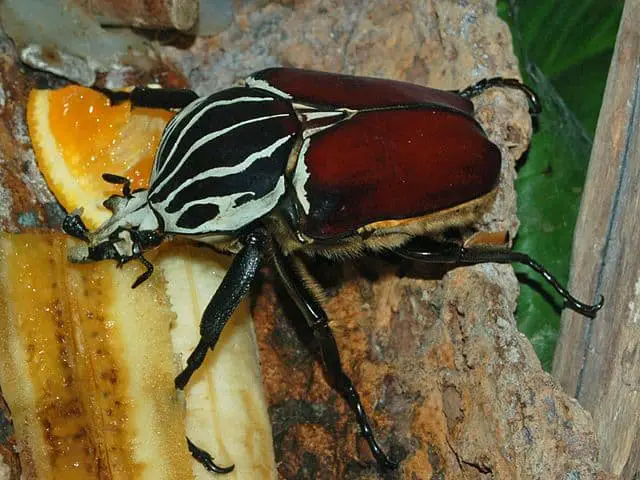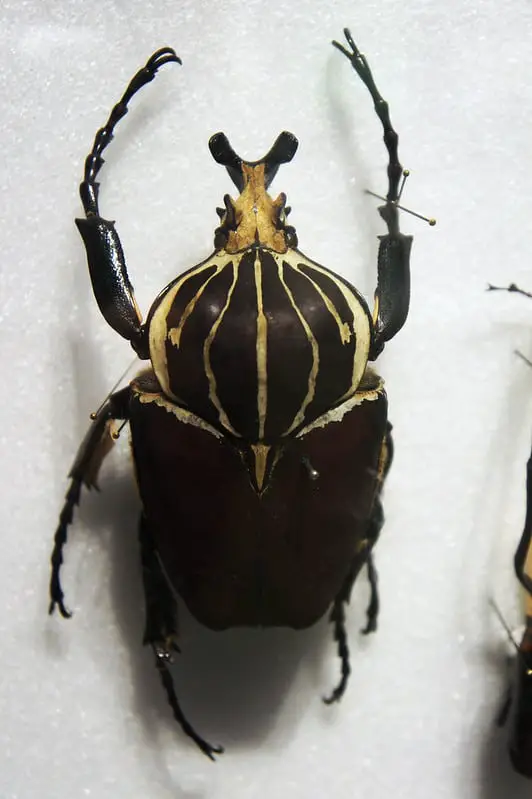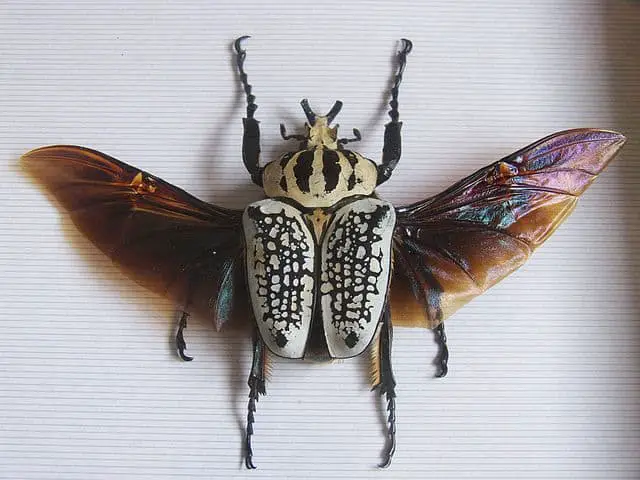The Goliath Beetle is a large and bulky beetle native to Central Africa. Topping out at an impressive 4.3 inches these insects have an appealing appearance. They are easily identifiable thanks to the pattern in their pronotum.
Their large size, unique appearance, and docile temperament have made them highly desired as pets. Today, we’re going to teach you everything you need to know to properly care for these beautiful beetles.
If you’re interested in getting one of these fantastic insects for yourself, read this guide and you’ll get all the information you need to figure out if this species is a good fit for you.

Goliath Beetle Care Sheet
| Name of species | Goliathus goliatus |
| Family | Scarabaeidae |
| Common name | Goliath Beetle |
| Category | Beetle |
| Type | Goliath beetles |
| Native location | Central Africa |
| Size | 2-4.3 inches (5-11cm) |
| Diet | Decaying wood, sap, and fruit |
| Lifespan | 6-12 Months |
| Experience level | Beginner |
Goliath Beetle Overview
There are actually 6 species in the Goliathus genus. These 6 species are:
- Goliathus goliathus
- Goliathus albosignatus
- Goliathus cacicus
- Goliathus kolbei
- Goliathus orientalis
- Goliathus regius
However, while these are distinct species, they are very similar in appearance and in care requirements. As such, while this guide is focused primarily on the Goliathus Goliathus, it is applicable to any of the Goliathus species.
The Goliathus goliatus is commonly known as Goliath Beetle. They can be found in the tropical forests of Africa, especially those around the Equator. This species can fly very well despite its large size, and you’ll often see adults feeding up bark, fruits, and sap. Aggressive towards its own kind, a GB is mostly peaceful towards humans, making it a great pet.
Appearance and variants

All Goliath Beetles bestow a bulky oval body with a white linear pattern over dark colors in its pronotum.
In the case of the Goliathus goliatus, the body is brownish red with the same white pattern over the pronotum and an outline of blue around its brown wings.
It displays sexual dimorphism, so males and females are different in appearance. Males have a y-shaped horn, which females do not have. In addition, males are quite a bit larger than females.
It’s also possible to sex these insects when they’re grubs, as third instar male larvae have a small dot in their abdomen.
Price
Goliath Beetles are popular pets with amazing appearance. However, they can be difficult to find and move between continents due to import restrictions.
Larvae can be found for around $60, and adult specimens will range from $130 to $150 depending on their size and where you get them.
Since there’s no easy way to tell the age of an adult beetle, it’s always better to get enough grubs to see them grow and carry them into adulthood. Otherwise, you may find you’ve purchased an adult GB that has less than one month left to live, which would be a waste of money.
Behavior and Temperament
The Goliath Beetle is territorial and aggressive. Males use their horns to fight over territory, food, and female specimens. Therefore, it’s a bad idea to place two males in the same tank.
A male’s aggressive behavior can spread to females, so you should also avoid keeping males with females in the same tank unless you’re trying to breed them.
They’re harmless to humans though, so you can attempt to handle them as long as you’re careful.
If you’re interested in holding them, you should know that grubs are fragile and can’t be dropped.
Now, with the adults, you’ll want to make sure not to force them out of any surface (including yourself) if they’re holding on to it strongly; forcing them out may harm their fragile legs.
Also, even though they lack teeth, their jaws can bite through human skin if they really want to. However, the bite isn’t venomous, and the worst you’ll get is some blood.
Caring for a Goliath Beetle
Goliath beetles are not particularly difficult to care for. They’re quite low maintenance and are able to thrive as long as you provide them with their basic necessities which are food, water, and a good tank that has optimal humidity and temperatures.
Here is what you need to properly care for your Goliath Beetle.
Temperature and Humidity
Goliath Beetles are used to the high temperatures and humidity of the African rainforests. You should keep them in temperatures around 73°F to 80°F and humidity between 70% and 80%.
These requirements are hard to achieve in some climates, so don’t hesitate to use heating rocks or mats to achieve this goal during cold seasons.
Substrate
Goliath Beetles don’t need as much substrate as other burrowing species, but it still needs to be the right kind.
Mixtures with peat moss and coconut fiber will work best since they need good moisture retention. Adults are comfortable with two inches of substrate, but they’ll need at least twelve inches if you’re planning to breed them since they burrow their eggs.
The ideal substrate composition for breeding is closer to what a GB grub would require, a mixture of flake soil and peat moss.
GB grubs, however, don’t need as much as twelve inches; five to six inches of substrate is enough for them.
Tank Setup
Goliath Beetles need plenty of space to move around and be comfortable. Tanks should be at least 4 gallons in size for an adult.
The enclosure should also be well ventilated and have a safety lid to keep them from escaping.
Make sure to have branches and bark as decorations in the enclosure since they’re essential for the beetle’s safety.
At times, your GB may find itself upside down, and it needs a firm support surface to flip itself back around or else it will die trying if you do not find it in time to help it.
Watering
Goliath Beetles get most of their hydration from their food; therefore, there’s no need to place a water dish in the enclosure. Nevertheless, if you want to be sure, there’s no harm in providing them with a shallow water dish that they can drink from.
As for the soil, the ideal moisture for grubs is when it’s moist enough to hold its shape between your fingers. Don’t take it so far that the substrate drips liquid when you squeeze it and you’re in the right spot.
Adults need slightly drier substrate, so make sure to reduce the frequency of the sprays once they reach maturity.
Diet & Feeding
Goliath Beetles have simple diets that are easy to follow, especially adult specimens.
Grown GBs feed on sweet fruit and rotten wood and sap, but you can give them beetle jelly at home. Beetle jelly is the best meal for these insects since it provides them with extra nutrients that will make them healthier.
There are homemade recipes for beetle jelly that you can use if store-bought jelly is out of your budget.
However, you can just use pieces of sweet fruit such as bananas and apples to feed them if you want to keep things simple.
Feed them every day and make sure to remove the remains daily to avoid mold formation.
Goliath Beetle grubs have different dietary requirements. Unlike the grubs from other species, a GB grub needs a high-protein diet to grow; therefore, placing them in an organic substrate and letting them feed on it isn’t going to be enough.
You’ll feed the grubs with koi fish food that has been soaked in water to meet their dietary requirements.
Also, make sure not to place two grubs in the same tank as they may cannibalize each other.
Fun Facts about the Goliath Beetle
- The Goliathus goliatus is one of the five species in the Cetoniinae subfamily. Members of the Goliathus, these five species share the name of Goliath Beetle. One of the biggest ones, the Goliathus goliatus is the most common and popular of the GBs; however, they’re all very similar.
- They are able to make noises audible to the human ear. You’ll also notice when they’re trying to fly since their flapping is also very loud.
- The Goliath Beetle takes its name from the biblical giant, Goliath. This is, of course, a reference to the amazing size of this insect.
Final words: Is the Goliath Beetle Right for you?
Goliath beetles are a welcome addition to any hobbyist’s collection. Once you know the perks of taking care of them, you understand how easy it is. It’s also very rewarding to be able to handle one of these magnificent insects and display it in front of your friends.
Experienced or beginner, this species has something to offer for anyone and is a must-have for anyone who’s serious about bug keeping.
Of course, there are also many other species you can consider if the Goliath is too expensive or simply not for you. Some great species to check out include:
They’re all unique and by looking around I’m convinced you’ll find a species that tickles your fancy.
- How Long Do American Eskimo Dogs Live? Important Factors and Care Tips - September 29, 2023
- Do American Bulldogs Need Grooming? Essential Tips and Care Guidelines - September 29, 2023
- Do Bengal Cats Enjoy Playing? Essential Tips for Keeping Them Active - September 29, 2023
